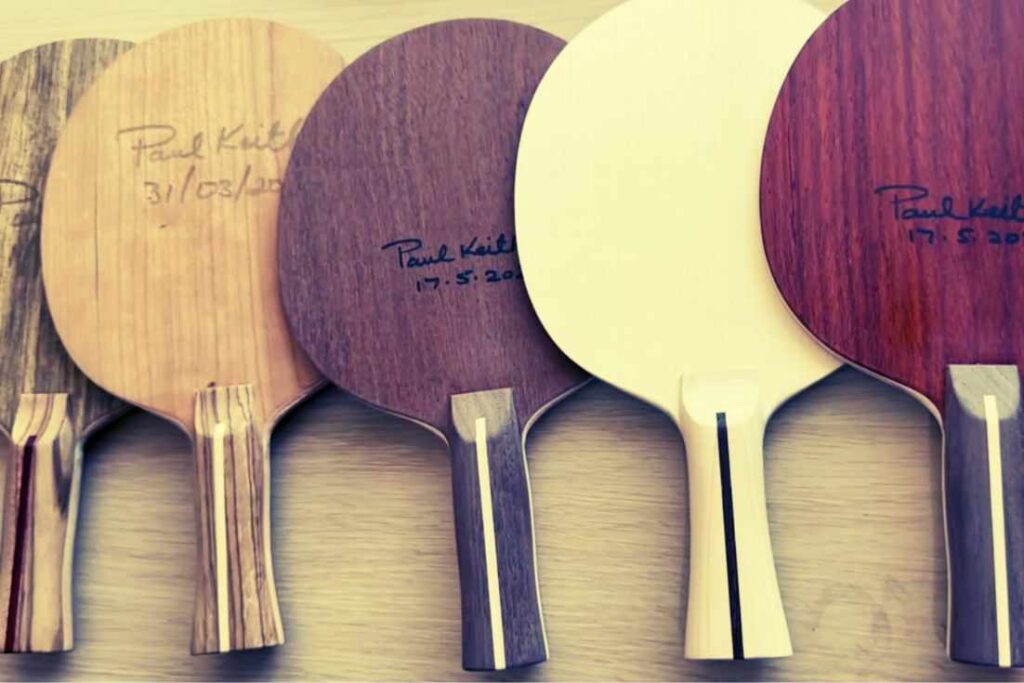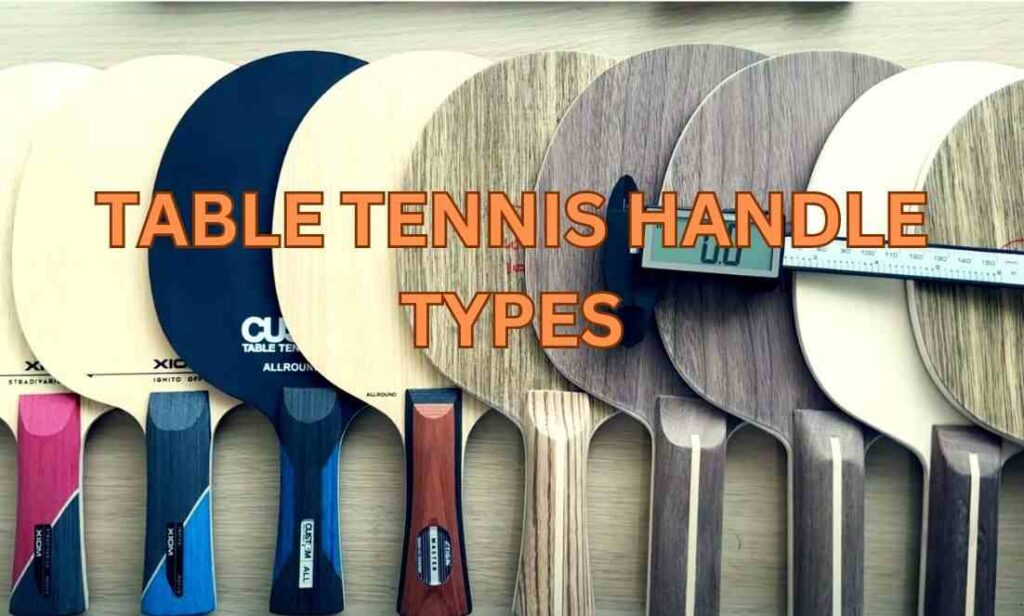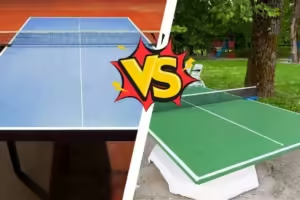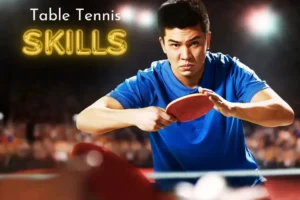Choosing the best table tennis handle types is more than just a technical decision—it’s about finding the perfect connection between you and your paddle. Every ping pong player knows that in the fast-paced world of table tennis, the choice of your racket’s handle is far from trivial. It’s the grip that connects you to the essence of the game, influencing your shots, spins, and overall performance. Selecting the right handle type is a decision that can’t be taken lightly, and it matters more than you might think.
In this blog, we’ll delve into the world of table tennis handles, exploring their significance and why making the correct choice is crucial for players of all levels. From the classic flared handle to exotic options like the Chinese or Japanese penhold, we’ll guide you through the pros and cons, helping you find the perfect fit for your playing style. Get ready to elevate your table tennis game as we unravel the secrets of these vital components.
Different Types of Ping Pong Grips:
A. Shakehand Grip Handle :
The shakehand grip is a widely adopted table tennis grip known for its versatility and effectiveness. The shakehand grip allows for a balanced control between power and finesse, making it a popular choice among players.
It offers a versatile playing style, enabling players to switch between offensive and defensive techniques with ease. The grip provides excellent control over the ball’s direction and spin, making it suitable for all-around play.
Players using the shakehand grip can employ both forehand and backhand shots effectively. Its adaptability suits various techniques, from powerful smashes to precise spins.
Prominent players like Ma Long and Jan-Ove Waldner are known for using the shakehand grip handle, showcasing its effectiveness at the highest levels of the sport.
B. Penhold Grip Handle:
The penhold grip is a distinctive table tennis grip characterized by holding the racket like a pen, with fingers wrapped around the handle and the thumb resting on the back of the blade.
Advantages of the penhold grip include exceptional control over the ball and the ability to execute deceptive spin shots, particularly on the forehand. However, it has certain disadvantages, such as limited reach for backhand shots.
Penhold players often utilize strategies like close-to-the-table play, quick transitions between forehand and backhand, and focus on spin variation. Notable players who favor the penhold grip include Xu Xin and Wang Hao.
C. Seemiller Grip Handle
The Seemiller grip is an unconventional yet effective table tennis grip characterized by holding the racket handle with all fingers together, creating a paddle-like grip with fingers spread wide apart.
The Seemiller grip is known for its exceptional blocking and quick transitions between forehand and backhand shots. This grip offers a broader paddle surface, allowing players to cover more ground during rallies.
Seemiller grip players typically adopt an aggressive style, relying on their quick reflexes and the ability to counteract opponents’ shots effectively. Techniques involve close-to-the-table play and expert placement of shots to keep opponents on the defensive.
Dan Seemiller, the grip’s namesake, is a notable player who has achieved significant success using this grip. Mark Hazinski is another accomplished Seemiller grip player.

Common Table Tennis Handle Types :
i) Straight Handles:
a) Benefits of Straight Handles:
Versatility: Straight handles allow players to change their grip during different game situations, favoring transitions between backhand and forehand shots. This versatility is advantageous for all-around players.
Freedom of Movement: Defensive players often prefer straight handles as they provide more freedom of movement. This can be especially beneficial for blocking and controlling the ball effectively.
b) Drawbacks of Straight Handles:
Reduced Lock-In: Unlike flared handles that offer a secure grip, straight handles don’t lock as firmly in your hand. This can lead to potential issues in maintaining control during powerful shots.
Less Wrist Flexibility: Straight handles can limit wrist flexibility, affecting the ability to generate spin on the ball, which is crucial in some playing styles.
ii) Flared Handles:
a) Benefits of Flared Handles:
Secure Grip: Flared handles offer a firm grip as they widen at the bottom. This ensures that the paddle stays securely in your hand, which is essential for power shots and serves.
Forehand Advantage: Flared handles are favored by players who rely on their forehand strokes. The design enhances control and maneuverability when playing forehand shots.
b) Drawbacks of Flared Handles:
Limited Backhand Play: The flared design, while beneficial for forehand strokes, can be less suitable for backhand play. It may restrict wrist movement, affecting the versatility of your shots.
Player Preference: The choice between flared and straight handles is often a matter of personal preference. What works best for one player may not be ideal for another, so finding the right fit is crucial.
iii) Anatomic Handles:
a) Benefits of Anatomic Handles:
Enhanced Comfort: Anatomic handles are designed for comfort and ergonomics, providing a secure and comfortable grip. This design reduces strain on the hand and wrist during extended play.
Improved Control: The widened middle section of an anatomic handle offers better control over your shots. This can be advantageous for players seeking precision and accuracy.
b) Drawbacks of Anatomic Handles:
Limited Adaptability: While anatomic handles excel in comfort and control, they may not suit all playing styles. Players who frequently switch between forehand and backhand shots may find them less adaptable.
Personal Preference: Choosing between table tennis handle types often comes down to personal preference. Anatomic handles may be preferred by some but not by others, making it essential to find the right fit for your playing style.
iv) Chinese Penhold Handles:
a) Benefits of Chinese Penhold Handles:
Flick and Loop from Backhand: Chinese penhold handles are known for their unique backhand grip, which allows players to execute flicks and loops effectively from the backhand corner. This provides an advantage in versatility during rallies.
Precise Control: The Chinese penhold grip offers precise control over the ball, making it ideal for players who prioritize placement and accuracy in their shots. The grip style allows for intricate placement and spin variation.
b) Drawbacks of Chinese Penhold Handles:
Limited Coverage on Forehand: One limitation of the Chinese penhold style is that it can be less effective on the forehand side, especially when it comes to powerful strokes. Players might need to adjust their technique for forehand shots.
Adaptation Required: Players transitioning to the Chinese penhold grip may face a learning curve, as it requires adjustments in both grip and shot execution. Adapting to this style can take time and practice.
v) Japanese Penhold Handles:
a) Benefits of Japanese Penhold Handles:
Quick Attack and Speed: Japanese penhold handles excel in quick, close-to-the-table attacking play. They provide maximum power and speed, allowing players to unleash rapid offensive shots.
Lightweight Design: Japanese penhold setups are typically lighter than traditional shakehand grips. This lightweight construction aids in agility and maneuverability during fast-paced rallies.
b) Drawbacks of Japanese Penhold Handles:
Limited Backhand Options: The Japanese penhold style restricts backhand play, as it lacks the versatility of a shakehand grip. Players using Japanese penhold grips may struggle with backhand shots.
Skill Requirement: Mastering the Japanese penhold technique requires skill and practice. Adapting to its unique grip style can be challenging for players accustomed to other table tennis handle types.
vi) Conical handles:
a) Benefits of Conical Handles:
Versatile Grip: Conical handles are known for their versatility, accommodating various grip styles. Players can comfortably switch between shakehand, penhold, and other grips, making them adaptable for different playing techniques.
Wrist Mobility: Conical handles allow for active use of the wrist, enhancing the player’s ability to impart spin on the ball and execute tricky shots. This wrist mobility can be advantageous for players who rely on spin in their gameplay.
b) Drawbacks of Conical Handles:
Less Specialization: While conical handles offer versatility, they may not excel in specific playing styles compared to dedicated handle types like flared or anatomic. Players seeking specialized grips for particular techniques may find conical handles less optimal.
Preference-Dependent: The suitability of conical handles is largely dependent on a player’s grip preferences. Some players may find other table tennis handle types more comfortable and suitable for their playing style.
Choosing the Right Handle Type:
a) Factors to Consider:
Hand Size: The size of your hands is a crucial factor. Anatomic handles are recommended for larger hands, providing a firm grip, while smaller hands may find flared handles more comfortable.
Playing Style: Your playing style influences handle choice. Penhold grips like Chinese or Japanese penhold are preferred for close-to-the-table quick attacks, while shakehand grips offer a variety of playing styles, from offensive to defensive.
Comfort and Control: Your comfort with the handle type and the level of control it provides are essential. A handle that feels natural and allows you to execute shots with precision is key.
b) Personal Preference vs. Playing Style:
Balancing personal preference with playing style is crucial. While some table tennis handle types may suit your style, your comfort and confidence with a particular handle matter just as much.
c) Trying Out Different Handle Types:
To find the best fit, try out various table tennis handle types. Experiment with different grips, handle shapes, and sizes to identify the one that enhances your performance and feels most comfortable.
In Closing:
Choosing the best table tennis handle types can significantly impact your game, providing the comfort and control you need to excel. Handle types like flared, straight, anatomic, and conical impact your playing style and comfort. Understanding your grip style, hand size, and personal preference is essential.
Players are encouraged to experiment with various table tennis handle types to find their ideal match. Personal preference plays a significant role, and trying different handles helps in discovering the one that optimizes performance.
The handle remains a fundamental aspect of table tennis equipment. It acts as the bridge between the player and the racket, influencing shot execution, ball control, and overall game performance. A well-suited handle is vital for players to excel.










